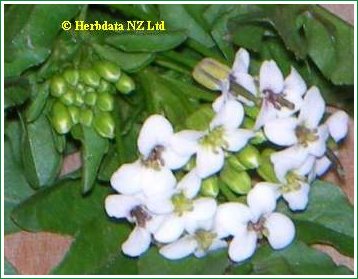
 WATERCRESS
- Nasturtium officinale
WATERCRESS
- Nasturtium officinale
Mrs. M. Grieve F.R.H.S.
Compiled by Ivor Hughes
U.S.D. 1926 Part II
Watercress. Cresson de
fontaine, Fr. Brunnenkresse, G. Radicula Nasturtium aquaticum (L.) Britten
et Rendle. (Nasturtium officinale R. Br.) (Roripa. Nasturtium Rusby) (Fam.
Cruciferae )
In sensible and medicinal properties
watercress bears some resemblance to: scurvy grass, though milder, and on
this account is preferred for the table. It is useful in scorbutic
affections. It contains a volatile oil, which according to A. W. Hofmann,
contains as its chief constituent a body boiling at 253� C., which he
considers to be the nitrile of phenyl-propionic acid, and therefore has the
formula C9H10N. Greenish states that the chief
constituent is phenyl-ethyl isothiocyanate. The expressed juice is sometimes
given in the dose
of one or two fluidounces (30-60 cc.); but the herb is more frequently used
in the form of a salad. Other species of Radicula grow in similar situations
with the R. Nasturtium, and act similarly.
Mrs. M. Grieve F.R.H.S.
WATERCRESS - Nasturtium
officinale. Parts Used. Leaves,
flowers, seeds. Fam.
Cruciferae. Habitat. Europe and
Russian Asia
Description. A hardy perennial found in abundance near springs and open running watercourses, of a creeping habit with smooth, shining, brownish-green, pinnatifid leaves and ovate, heart-shaped leaflets, the terminal one being larger than the rest. Flowers small and white, produced towards the extremity of the branches in a sort of terminal panicle. The true nasturtium or Indian Cress cultivated in gardens as a creeper has brilliant orange-red flowers and produces the seeds which serve as a substitute for capers in pickles. The poisonous Marshwort or 'Fool's Cress' is often mistaken for Watercress, with which it is sometimes found growing. It may readily be distinguished by its hemlock-like white flowers, and when out of flower, by its finely toothed and somewhat pointed leaves, much longer than those of the watercress and of a paler green. The Latin name 'Nasturtium' is derived from the words nasus tortus fa (convulsed nose.) on account of its pungency.
Constituents. A sulpho-nitrogenous oil, iodine iron, phosphates, potash, with other mineral salts, bitter extract and water. Its volatile oil rich in nitrogen combined with some sulphur in the sulpho-cyanide of allyl.
Medicinal Action and Uses. Watercress is particularly valuable for its antiscorbutic qualities and has been used as such from the earliest times. As a salad it promotes appetite. Culpepper says that the leaves bruised or the juice will free the face from blotches, spots and blemishes, when applied as a lotion.
Dosage. Expressed juice, 1 to 2 fluid ounces.
Watercress has also been used as a
specific in tuberculosis. Its active principles are said to be at their best
when the plant is in flower.
Watercress. Portion 100 gram raw:
Water 95 gram. Protein 2.30 gram. Total lipids 0.10 gram. Calcium 120 mg. Iron 0.20 mg. Magnesium. 21 mg. Phosphorus 60 mg. Potassium 330 mg. Sodium 41 mg. Zinc 11 mg. Copper 0.077 mg. Manganese 0.244 mg. Selenium 0.9 mg. Vitamin C 43 mg. Thiamin 0.090 mg. Riboflavin 0.120 mg. Niacin 0.200 mg. Pantothenic acid. 0.310 mg. Vitamin B6 0.129 mg. Vitamin A I.U. 4700. Vitamin E 1.000 mg.
If you did not find what you were seeking use the site search box at the top right hand of the page or peruse the main library.
![]()